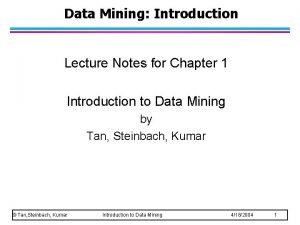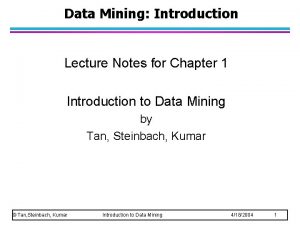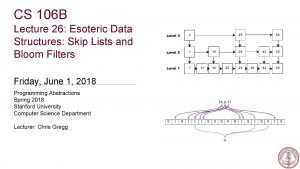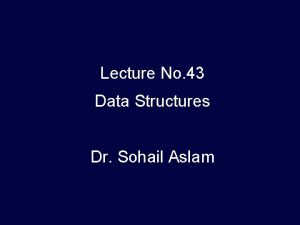Data Structures Lecture 30 Sohail Aslam 1 Inserting





















- Slides: 21

Data Structures Lecture 30 Sohail Aslam 1

Inserting into a Heap 1 insert(15) with exchange 13 2 14 3 16 4 24 8 5 9 26 10 32 65 6 19 21 7 68 11 31 12 15 13 14 16 24 21 19 68 65 26 32 31 15 0 1 2 3 4 5 6 7 8 9 10 11 12 13 14 2

Inserting into a Heap 1 insert(15) with exchange 13 2 14 3 16 4 24 8 5 9 26 10 32 65 6 21 11 31 15 7 68 12 19 13 14 16 24 21 15 68 65 26 32 31 19 0 1 2 3 4 5 6 7 8 9 10 11 12 13 14 3

Inserting into a Heap 1 insert(15) with exchange 13 2 14 3 15 4 24 8 5 9 26 10 32 65 6 16 21 11 31 7 68 12 19 13 14 15 24 21 16 68 65 26 32 31 19 0 1 2 3 4 5 6 7 8 9 10 11 12 13 14 4

Inserting into a Heap 1 insert(15) with exchange 13 2 14 3 15 4 24 8 5 9 26 10 32 65 6 16 21 11 31 7 68 12 19 13 14 15 24 21 16 68 65 26 32 31 19 0 1 2 3 4 5 6 7 8 9 10 11 12 13 14 5

Delete. Min § Finding the minimum is easy; it is at the top of the heap. § Deleting it (or removing it) causes a hole which needs to be filled. 1 13 2 14 4 24 8 65 9 26 10 32 3 16 5 21 6 19 7 68 11 31 6

Delete. Min delete. Min() 1 2 14 4 24 8 65 9 26 10 32 3 16 5 21 6 19 7 68 11 31 7

Delete. Min delete. Min() 1 14 2 4 24 8 65 9 26 10 32 3 16 5 21 6 19 7 68 11 31 8

Delete. Min delete. Min() 1 14 2 21 4 24 8 65 9 26 10 32 3 16 5 6 19 7 68 11 31 9

Delete. Min delete. Min() 1 14 2 21 4 24 8 65 9 26 10 32 3 16 5 31 6 19 7 68 11 10

Delete. Min delete. Min(): heap size is reduced by 1. 1 14 2 21 4 24 8 65 3 16 5 31 6 19 7 68 9 26 10 32 11

Build. Heap § Suppose we are given as input N keys (or items) and we want to build a heap of the keys. § Obviously, this can be done with N successive inserts. § Each call to insert will either take unit time (leaf node) or log 2 N (if new key percolates all the way up to the root). 12

Build. Heap § The worst time for building a heap of N keys could be Nlog 2 N. § It turns out that we can build a heap in linear time. 13

Build. Heap § Suppose we have a method percolate. Down(p) which moves down the key in node p downwards. § This is what was happening in delete. Min. 14

Build. Heap Initial data (N=15) 65 31 32 26 21 19 68 13 24 15 14 16 5 70 12 0 1 2 3 4 5 6 7 8 9 10 11 12 13 14 15 15

Build. Heap 1 Initial data (N=15) 65 2 31 3 32 4 26 8 5 9 24 10 15 13 6 19 21 11 14 12 16 7 68 13 5 14 70 15 12 65 31 32 26 21 19 68 13 24 15 14 16 5 70 12 0 1 2 3 4 5 6 7 8 9 10 11 12 13 14 15 16

Build. Heap § The general algorithm is to place the N keys in an array and consider it to be an unordered binary tree. § The following algorithm will build a heap out of N keys. for( i = N/2; i > 0; i-- ) percolate. Down(i); 17

Build. Heap 1 i = 15/2 = 7 65 Why I=n/2? 2 31 3 32 4 26 8 5 9 24 10 15 13 6 19 21 11 14 12 16 7 68 13 5 14 70 i 15 12 i 65 31 32 26 21 19 68 13 24 15 14 16 5 70 12 0 1 2 3 4 5 6 7 8 9 10 11 12 13 14 15 18

Build. Heap 1 i = 15/2 = 7 65 2 31 3 32 4 26 8 5 9 24 10 15 13 6 19 21 11 14 12 16 7 12 13 5 14 70 i 15 68 i 65 31 32 26 21 19 12 13 24 15 14 16 5 70 68 0 1 2 3 4 5 6 7 8 9 10 11 12 13 14 15 19

Build. Heap 1 i=6 65 2 31 3 32 4 26 8 5 9 24 10 15 13 6 19 21 11 14 12 16 i 7 12 13 5 14 70 15 68 i 65 31 32 26 21 19 12 13 24 15 14 16 5 70 68 0 1 2 3 4 5 6 7 8 9 10 11 12 13 14 15 20

Build. Heap 1 i=5 65 2 31 3 32 4 26 8 5 9 24 10 15 13 21 6 5 i 11 14 12 16 7 12 13 19 14 70 15 68 i 65 31 32 26 21 5 12 13 24 15 14 16 19 70 68 0 1 2 3 4 5 6 7 8 9 10 11 12 13 14 15 21
 Dr sohail aslam
Dr sohail aslam Dr sohail lectures
Dr sohail lectures Dian laundry
Dian laundry Aslam has to study four books
Aslam has to study four books Hivnet
Hivnet 01:640:244 lecture notes - lecture 15: plat, idah, farad
01:640:244 lecture notes - lecture 15: plat, idah, farad Homologous structures and analogous structures
Homologous structures and analogous structures Exploratory data analysis lecture notes
Exploratory data analysis lecture notes Bayesian classification in data mining lecture notes
Bayesian classification in data mining lecture notes Data mining lecture notes
Data mining lecture notes Data visualization lecture
Data visualization lecture Data mining lecture notes
Data mining lecture notes Data mining lecture notes
Data mining lecture notes Btechsmartclass.com
Btechsmartclass.com R data structures
R data structures Oblivious data structures
Oblivious data structures Kernel data structures
Kernel data structures Introduction to data structures
Introduction to data structures Introduction to data structures
Introduction to data structures Professor ajit diwan
Professor ajit diwan Esoteric data structures
Esoteric data structures Geometric data structures
Geometric data structures







































